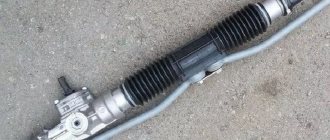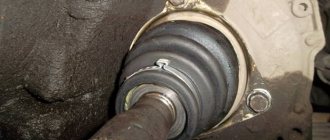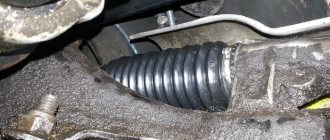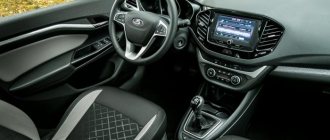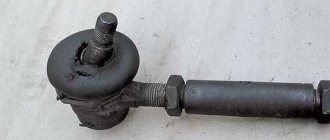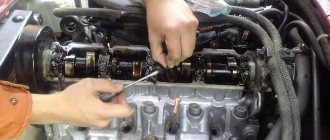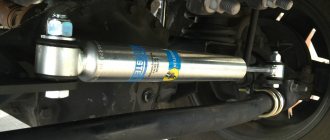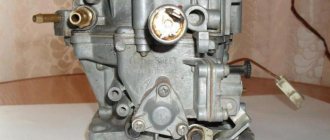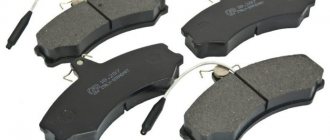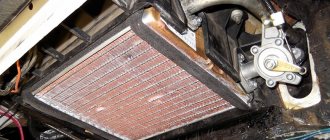Power steering rack malfunctions
Symptoms of a faulty steering rack with power steering are often associated specifically with the hydraulic system - fluid and pump. So, if a hydraulic rack breaks down, the driver will feel:
- Increased effort when turning the steering wheel. In other words, the steering wheel becomes “heavy”, and if you could literally turn it with one finger, now you need to make significant efforts to turn it.
- Regular decrease in power steering fluid level in the expansion tank. This is indicated by a corresponding lamp on the dashboard, fluid leaks under the car or on elements of the engine compartment.
- Knock when driving. It is especially clearly expressed when driving on uneven roads.
- When turning the steering wheel, a strong hum is heard. And the more the steering wheel is turned (no matter in which direction), the louder the noise becomes. Often the hum is accompanied by a slight vibration of the steering wheel.
- After turning the steering wheel, it slowly or does not return to its original position.
- When the car moves straight, the front wheels do not maintain the trajectory, which is why the car “fidgets” along the road.
Sounds from the cabin
In modern cars, the steering wheel is not only needed to turn the car. It often houses controls for certain devices, from changing gears to turning on headlights or adjusting the audio system. Therefore, the driver has a natural concern when clicks appear in the steering column when turning the steering wheel. It is typical that the sound comes from inside the cabin from the area of the horn button.
In this case, there is no need to panic. First, you should check the correct installation and condition of the plastic lining of the column. The possibility of plastic deformation cannot be ruled out. A common reason for this phenomenon is a malfunction of individual elements of the steering column switch that produce such sounds. You can check the quality and fastening of the plastic, and replace the faulty switch. Often this is enough so that when you turn the steering wheel you won’t hear a click in the steering column.
Sometimes in the front part of the cabin, when you turn the steering wheel, squeaks are heard, similar to shuffling. Their source is hidden under the beep button on top of the speaker. At the same time, the signal for a problem with the airbag in the steering wheel comes on, and the cruise control buttons do not work.
We recommend: Clutch repair. Repair of discs and master cylinder
This means that the steering column cable under the airbag is inoperative. It supplies power to the mechanism of this airbag, the horn and some other devices of the car. It could simply be seriously damaged. Some motorists try to fix such faults on their own. This does not provide any guarantee of reliable operation of the cable. Taking into account the fact that this device affects safety, it is better to replace the steering column cable by experienced car service workers.
Electric steering rack malfunctions
In general, electric rack malfunctions are similar to hydraulic rack problems, except for fluid leaks. So, when a rack with an EUR fails, it often happens:
- knocking noise when turning the steering wheel;
- biting the steering wheel;
- uneven force on the steering wheel;
- spontaneous rotation of the steering wheel;
- The red steering wheel icon is lit on the instrument panel.
In general, electric rack malfunctions are similar to hydraulic rack problems, but they are caused by slightly different reasons, which will be discussed below. The main problem in this case is water that gets onto the rod or into the rack control unit.
Causes of steering rack malfunction
There are three main reasons why you may hear a knock in the steering rack. This is wear of the worm pair (distributor), wear of the toothed part of the shaft, wear of the shaft along the bushing.
Thus, the most loaded unit in its design is the clutch between the gear and the gear base. Accordingly, the teeth here may collapse over time - partially or even completely. This can be understood by the knocking sound when holding the steering wheel while driving over uneven surfaces. If there is no wear on the teeth but slight play on the rod, the situation can be corrected using an adjusting nut. By tightening it, you will establish the optimal distance between the teeth of the rack and pinion. If the teeth are completely broken, then such a rack must be replaced (sometimes only the gear can be replaced). When a hole has formed in the bushing. Due to corrosion, due to the ingress of moisture, an abrasive appears inside, which eats the bushing (can be plastic or bronze). The malfunction is eliminated by replacement from a special repair kit.
Another cause of failure is wear of the tie rod end or the entire tie rod. This happens due to the rupture of the boot and washout of the lubricant. Usually these parts cannot be repaired, and accordingly, they are replaced with new ones. Same with the ball end. The thrust is located in the anther, which over time or under the influence of external factors can lose its integrity. Accordingly, dust, dirt, and water get into it, which plays the role of an abrasive. When moving, the abrasive significantly wears out the rod and dirt gets into the rail, breaking it.
If the car “fidgets” on the road or the steering wheel does not return well to its original position, it means that the steering rack is poorly adjusted (although other options are possible, so additional diagnostics are needed). Next, we will consider the main reasons why the power steering rack (hydraulic and electric steering rack) fails.
Repair or complete replacement
If funds allow, then it is worth purchasing new parts, as they guarantee maximum service life. However, the cost of the gearbox is quite high. There is always a temptation to buy non-original parts. Sometimes they will not be inferior in quality to products from the official manufacturer, but there is always a chance to stumble upon a low-quality product.
An alternative option is to make high-quality repairs. To do this, a special repair kit is purchased, and then the oil seals, anthers and other components are replaced. If you have some experience in car repairs, then you can do it yourself. Otherwise, it is naturally recommended to contact a specialized auto repair shop. Repairing a power steering system is difficult, so it must be done by highly qualified craftsmen.
Why does the power steering rack malfunction?
Reasons why steering rack and power steering malfunctions occur:
- Shaft rusting . Modern manufacturers do not always make the steering rack drive shaft from high-quality metal, and certainly do not apply a large anti-corrosion layer to it. For this reason, rusting of the shaft housing, which “walks” along the seals, often occurs. Because of this, the thickness of the shaft decreases and power steering fluid may leak with all the ensuing consequences. It often rusts after the car has been parked for a long time, for example, in the autumn-winter period.
- Wear of rubber seals of the power steering system . This applies both directly to the oil seals and seals in the rack, and to connections located in other parts of the system, for example, in the area of the expansion tank. Over time or under the influence of mechanical reasons (tanning, overheating), rubber products lose their properties, which is why they can leak liquid, and, accordingly, its level in the system will decrease.
- Partial failure of the power steering pump . This usually happens for natural reasons (wear) or when using low-quality power steering fluid. In particular, the power steering pump wears out greatly with frequent significant turns of the wheels, especially in a situation where the car with the wheels turned out is left in this position for a long time.
- Malfunction of distributor valves . This leads to improper movement of fluid through the system, and, accordingly, to the operation of the amplifier.
- Damage to the hydraulic cylinder piston system . Because of this, the necessary pressure will not be created in the system.
- Loose or broken pump drive belt . If the belt breaks completely, then the pump will not work; this failure is critical. However, often the belt simply stretches (wears out) over time, so it can slip on the pulleys, which is why it does not transmit to the pump the angular velocity necessary for normal operation. Accordingly, the pump will not create the necessary pressure in the system.
Rusting rack
It is worth mentioning corrosion separately, since it is for this reason that the steering rack most often begins to creak. The fact is that often when repairing (replacing) slats in a car service center, their employees fix the boots with universal plastic clamps, since they are easier to install. However, plastic clamps do not provide proper sealing of the boot.
Most rack manufacturers make special slots on their housings for air circulation. And since there are two clamps - above and below, one of them sucks in air from below, where it is cold, and the second - from above, where it is warm. As a result, condensation and rust appear on the surface of the rack. As practice shows, it takes about six months for rust spots to appear.
Hull development
This reason only occurs on a power steering rack. Grooves inside the body appear due to rare fluid changes. Metal wear impurities appear and stick to the Teflon rings.
Such an abrasive eats the body like a rasp. It can only be eliminated by replacing the rack. The problem is not critical, but it is not very pleasant, because you will have a constant knock on the steering wheel.
Causes of knocking
The rack design is highly reliable, but has some disadvantages. These include the complexity of installation, sensitivity to shock loads, etc. Vibrations and other “impacts” disable components that begin to produce a loud knock.
The reasons for this are:
Wear of the bushing, which is installed on one side of the rack. The car owner hears a knock after a backlash forms in the structure.
Weak tightness in the design can provoke strange sounds. But the problem is easy to fix - you just need to tighten the fasteners.
The occurrence of corrosion. Rusty deposits tend to destroy metal.
The problem is the anthers, which trap dirt. It is dust that increases wear on the part.
Crankcase deformation.
Knocking and tight turning of the steering wheel can also be caused by prolonged idleness of the car. If the knocking is accompanied by a hum, it means that the breakdown has occurred in the power steering pump. It requires replacement. To avoid knocking, it is necessary to regularly inspect the slats. They are made of soft metal, which means they tend to wear out quickly.
Causes of malfunctions of the electric power-assisted rack
The causes of failure of the electric steering rack may be malfunctions of the following components included in its composition:
- Electronic control unit . It issues commands to the electric motor based on information received from the rotary sensors. The unit fails extremely rarely, but sometimes it can, as they say, “fail.” There are also exotic options, for example, a pebble got on the plastic cover, made a crack, and moisture began to get inside the case through it. The result is oxidation of the contacts of the electronic unit. Repairing it at home is impossible, so you need to contact a car service center for help.
- Reversible electric motor with worm drive . This is the main actuator that drives the shaft. Like any electric motor, it has a number of typical possible malfunctions - wear of the graphite brushes, short circuit or breakage of the armature wiring, wear of the support bushings. Usually the engine can be repaired at a car repair shop.
- Worm drive . In particular, the worm gear - it can wear out or the teeth in it can wear out. As a rule, in this case, the corresponding unit is replaced.
- Rotary sensors and cable . If they fail or operate incorrectly, the operation of the entire EUR is disrupted. As a result, you receive incorrect or delayed steering response. The electronics do not understand with what force and which side you need to help turn. Depending on the type of sensors (analog or digital), the cause of such a breakdown may be wear, which causes a deviation from the central position or damage to the cable, and then the amplifier turns off altogether at a certain moment.
- Bushings and bearings . Over time, the internal bushings of the electric amplifier may partially fail, which leads to a hum during its operation. Wear of the bushing leads to biting or even jamming of the steering mechanism. Often the steering wheel begins to vibrate when turning. if the electric motor bearing is worn out due to moisture ingress, then you will begin to hear a howling noise when turning.
TOP 5 reasons why the car steering wheel knocks when driving!
1. Knock in the steering wheel on uneven roads when driving straight.
Sometimes a knock occurs when driving on an uneven road. The cause may be worn-out shaft bearings located inside the steering column. As a result, radial play of the shaft occurs, accompanied by this knocking sound. If the O-ring or retaining ring is worn, this can also lead to end play. This can be partly solved by inexpensive repair of the column due to the provided supply of necessary spare parts.
Along with replacing faulty elements, specialists also replace related elements and parts that may be serviceable, but soon will probably again require repair of the entire assembly due to their failure while driving.
Some car models have a non-removable column that cannot be restored. In this case, the entire column changes.
2. Knock when turning the steering wheel while standing still or in motion
First of all, it is worth checking the tire pressure - differently inflated wheels can also cause knocking noise when the car is moving. Next, inspect the fastening of the plastic fender liners. Probably, one or more mounting screws have broken out, which is why the fender liner touches the wheel when turning and makes a corresponding knock. The problem can be easily fixed. You just need to replace the loose fasteners with new ones.
The greatest danger is caused by malfunctions accompanied by a knocking sound from the steering mechanism itself when turning the steering wheel. The sound may be localized closer to the suspension, wheels or steering wheel. Let's look at the reasons for its occurrence, starting with the most common.
3. Constant velocity joints
A knocking sound when the steering wheel is turned while driving is usually associated with the operation of the outer CV joint, which begins to creak or, in some cases, hit the wheel. Accordingly, when turning left, a crunch or knock will occur in the right CV joint, and when turning right, in the left one.
Internal hinges, as a rule, make a squeaking or knocking sound when moving at high speed over uneven surfaces. They do not react at all to steering wheel turns. Therefore, if turning or sharp acceleration of the car is accompanied by a knocking noise, most likely the outer joint needs to be replaced. But before replacing it, you should carefully inspect it. If there is little or no wear, it is enough to treat the CV joint with appropriate lubricant.
4. Tie rods and tie rods
Both the tips and the rods in the steering system wear out over time, causing play. As a result, squeaks and knocks appear when the car turns while driving.
To check the condition of the parts, jack up the car on the side where the sounds are coming from and remove the wheel. Then try to loosen the rods and tips, thus checking for possible play. Often, dirt and water accumulate inside the tip due to a torn boot, which is why the knocking occurs.
Sometimes a distinct metallic knock when turning the steering wheel in a stationary car or while driving appears due to the fact that the car owner forgot to secure the tie rod with the end after performing a wheel alignment. You can verify this by shaking the wheel left and right with your hands. If the wheel wobbles, making a characteristic sound, the problem is precisely the loose nut.
5. Steering rack
A faulty steering rack quite often causes knocking noises when turning the steering wheel, both while driving and when the car is stationary. Why does this knock occur? There are several reasons for this:
- The steering gear fasteners are not tightened properly.
- The plastic support bushing of the steering wheel was severely worn, creating play.
- Play appeared in the steering rack shaft bearings.
- The gap between the rack teeth has increased, creating backlash and causing dull knocks when turning the steering wheel on a stationary car.
- The anti-friction gasket was completely worn out, as a result of which the clamping “cracker” began to vibrate and knock on the steering rack housing.
Detecting a knock in the steering rack is a rather difficult task. It is best to use the help of a partner by asking him to sit behind the wheel of the car, previously placed on the handbrake, and position himself under the car near the steering rack. Let the assistant rotate the steering wheel, and at this time you note the creaks and crunches coming from the rack, which will signal a malfunction.
Subscribe, comment, like!
Useful materials about cars
here!
How to check the steering rack for malfunction and what to do
Diagnosis of a steering rack malfunction must be performed based on the symptoms that appear during operation. To begin with, we will describe the diagnostics of the power steering rack.
Noise when turning
If you hear a hum when the steering wheel is turned to its extreme (or close to it) position, it means that you need to check the condition of the hydraulic or electric booster and the components of its working system. In this case, a hum may occur even if the fluid level is normal. You need to check the condition of the pump blades (often, over time, the pump’s performance decreases), the condition of its bearings, and the tension of the drive belt.
Power steering fluid leak
Regular leakage is a reason to check the power steering system and its seals. In particular, if the car owner is forced to frequently add fluid to the system’s expansion tank. In this case, a concomitant symptom of a faulty steering rack will be a fluid leak from the line. It can drain directly onto the ground under the car (usually right under the expansion tank) or streaks can be seen on the steering linkage boots. Often, when a liquid leaks, air enters the system (the system is “aired”). It can be seen by the bubbling liquid in the expansion tank. As stated above, the cause of the leak may be rust on the rack. To get rid of it in the future, it is advisable to use non-standard plastic clamps to tighten the anthers, and their metal counterparts, which provide a higher level of tightness.
Knock when driving in the front axle
In fact, such a knock may also indicate a malfunction in the vehicle’s chassis, so additional diagnostics must be performed. The knock can be either in the center or on the left or right side. In the best case, a knock may indicate a torn traction boot; in the worst case, it can indicate problems with the rods, levers or other elements. To understand exactly why such a malfunction occurred, it is better to remove and disassemble the rack. After all, the most harmless thing may be a loose adjusting nut or wear of the bushing (when there is a knock on the right), but a more serious problem is wear of the worm pair.
Torn boot on traction
When checking the performance of the rack, it is necessary to pay attention to the integrity of the traction boot. Ideally, it should be intact and the rubber should be elastic. If it is torn and dirt has gotten inside, it must be replaced, lubricant must be added after removing dirt, moisture, and debris from the mechanisms.
Electric power steering rack
To localize faults in the electric steering rack, it is necessary to check the following elements.
Broken bushings
Most often, the cause of a hum and/or rattling of the steering wheel when turning (and even without it) is broken bushings. Accordingly, it is necessary to carry out dismantling work and check their condition. Usually they cannot be restored. Therefore, you can do it in two ways - change the electric amplifier along with the rack assembly, or buy and use a repair kit, including bushings.
At the same time, it makes sense to check the condition of the worm gear (gear). It fails much less frequently, however, if the car has a high mileage, it is definitely worth checking it.
Turn sensors
The operation of torque sensors is checked using computer diagnostics. Here it is advisable to seek help from a car service center. But, as a rule, sensors are quite reliable devices, so they rarely fail. such a sensor begins to “fail” if the boot that is installed above it is damaged and moisture gets inside.
Electric steering
In modern VAZs with electric power steering, with significant mileage, problems with the electric motor may occur. This can be felt by the increasing force on the steering wheel. Accordingly, in this case it is advisable to check the condition of the brushes, bearings and windings of the electric motor.
Similarly, as when checking a hydraulic rack, you need to pay attention to the condition of the boot, tips, and rods.
Repair procedure
Having purchased the necessary repair kit, you can begin dismantling. Here it is necessary to follow a certain algorithm consisting of the following steps:
- Completely dismantle the steering rack.
- Remove the tie rods.
- Clean the structure from dirt accumulated during operation.
- Replace worn parts.
- Inspect the shaft and install a new one if necessary.
Why remove the tie rods? This will greatly simplify the process of installing new boots. By pulling them onto the corresponding protrusions on the rod, you can achieve maximum tightness. Before assembling the rack, be sure to lubricate the internal oil seal.
If your car has a hydraulic booster, then you will first need to disconnect the high pressure pipes and then drain the working fluid into a prepared container. It is not recommended to remove the gearbox with hydraulic power steering yourself. The procedure involves dismantling the subframe, and it is impossible to do it alone.
The described technique will eliminate knocking in the steering rack. To complete the procedure, you will need a set of keys and screwdrivers, a garage with a pit. You can also always contact a car service center, where all the above operations will be performed by auto mechanics. But be careful, as they may jack up the cost of repairs or supply low-quality consumables.
Consequences of a faulty steering rack
Drivers are also often interested in the question of what causes a faulty steering rack, and can it be used in this condition? And to understand the consequences, it is enough to know the function of the steering rack. That is, the first thing that threatens the failure of the rack is impaired control of the car. And if at the initial stage (when the rack just started to creak and/or hum) it still performs its functions, then if it completely fails, the driver may completely lose control of the car! If a steering rack malfunction is detected, it is necessary not to delay diagnostics and repair work!
The answer to the question of repairing or replacing with a new rack is ambiguous and requires an integrated approach. The most expensive but reliable option is replacement with an original spare part. But not everyone has this opportunity, so this option can only be recommended to owners of expensive premium foreign cars, or to car owners who can afford not to save money.
Most car enthusiasts buy so-called non-original slats or contract ones, but still in good condition.
Another option is to purchase and use a repair kit. It includes anthers, oil seals, bushings. This is the path most often chosen.
But there are two aspects to this. The first is the quality of such a repair kit. There is no point in chasing cheapness.
The second aspect is who will do the repairs. This question is very relevant, since the repairman must have the appropriate experience. Therefore, buying a good quality repair kit and contacting a trusted car service is a very good repair option that allows you to save a lot of money.
Just be sure to ask for a guarantee on the work performed. And keep the warranty on the purchased rail or repair kit.
But if it comes to a rack with an electronic power steering, then repair is more often chosen, since no matter how complex the malfunction, the service always recommends replacing the part with a new one. Few people want to bother with repairs. Since grinding, if it is a mechanical problem, is not acceptable, and electronic faults require a lot of time and skills, both diagnostics and soldering. Here everyone chooses for himself what is more accessible to him.
Did not find an answer to your question? Ask in the comments. We will definitely answer!
Diagnostics and repairSeptember 22, 2017A steering rack is a mechanism responsible for turning the front wheels of a car and connected to them through rods. Like any other unit, the element gradually wears out during operation, which negatively affects the controllability of the machine. Since this problem is related to the safety of the driver and passengers, the car owner needs to recognize the signs of a faulty steering rack in order to fix them as soon as possible or install a new spare part.
How to choose good spare parts for the steering system?
Let's say you found a problem and want to fix it. In this case, you will need to purchase ends, linkages or steering assemblies. There are dozens of manufacturers who offer their solutions in this case. But the problem is that most of them are not worthy of your attention. You should be very careful about the fact that a variety of difficulties may arise during the operation of inexpensive spare parts. When selecting, you should carefully evaluate several important factors and choose the optimal parts.
Here are just a few features to consider:
- brand - not always a well-known brand produces good spare parts for your car; famous factories are also represented on the Russian market in a huge number of fakes;
- price - a good spare part cannot be three times cheaper than the original one, it is important to refuse to purchase very cheap rods and ends, as this is simply unsafe for you;
- appearance - inspect the parts and make sure that they were produced on good industrial equipment, this can usually be seen by various criteria, including the quality of metal preparation;
- packaging - most high-quality automobile parts are packed in sealed film, as well as in a cardboard box; the lack of packaging indicates a fake or defective product;
- supplier - do not buy components for your car in unverified places, this can be very dangerous for your vehicle and cause its obvious problems.
It is best to take original spare parts, even if this is the most expensive option. However, originals sometimes cost unreasonably a lot of money. This suggests that it is worth paying more attention to suppliers. Sometimes the original can be bought in a third-party store for half the price than on the official service. Officials make money on spare parts, this is their main business. But when buying in a regular store, be very careful and avoid purchasing obvious fakes. You definitely won't get any benefit from them.
Briefly about the mechanism
The element is a cylindrical body containing the following parts:
- the gear rack itself, moving inside the bushings;
- drive shaft with helical gear, rotating on 2 bearings (connected to the steering column);
- 2 rods connected to the ends of the rack and pinion mechanism and the steering knuckles of the hubs;
- a system of stops and springs that limit the travel of the rack and select the backlash of the gear transmission;
- rubber covers (anthers) in the form of round “accordions” that protect the mechanism crankcase from dirt;
- the element body is filled with liquid lubricant.
This is the design of a conventional mechanical and so-called electric rack, operating in conjunction with an electric power steering (EPS). If the car is equipped with a hydraulic booster (power steering), then the design of the mechanism is supplemented with cylinders and pistons that help move the gear bar in one direction or another.
The element works on a simple principle: when the steering wheel rotates, the drive shaft moves the rack through a gear in the required direction. The ends of the part connected to the rods cause the front wheels to turn. The power steering or electric power steering reacts to the movement of the steering wheel and “pushes” the rack and pinion mechanism in the desired direction, relieving physical stress from the driver.
Tie rod design
In order to independently determine the degree of wear of the tips, you need to at least understand their structure in general terms. The rod is a metal rod with a thread at one end and a hinge at the other. The threaded part is used to connect to the rack or gearbox, and the ball pin is inserted into the eye of the steering knuckle and secured with a nut.
The wear of the steering tips implies the wear and tear of the hinge itself, which consists of the following parts:
- cylindrical body, closed on one side with a plug;
- a ball pin resting its lower part on the supporting heel;
- a spring is installed at the bottom between the fifth and the plug;
- An insert made of wear-resistant plastic is provided between the body and the ball;
- The top of the case is covered with a rubber or silicone cover.
Signs of trouble
Since most passenger cars are equipped with a hydraulic booster, wear symptoms should be considered in conjunction with the power steering elements - pump, control valve and oil lines.
Problems with the operation of the rack and pinion mechanism are divided into obvious and hidden. The motorist himself can identify the former while driving or as a result of inspecting components and assemblies. In the second case, the service station technician can clearly identify the fault. Your task is to react in time and contact a service station if the following symptoms appear:
- A knocking sound heard from the front of the car when driving over uneven surfaces, especially when turning. The sound location is approximately in the center where the rail is installed.
- When driving over small bumps or loose surfaces, vibration is clearly transmitted to the steering wheel.
- After completing a turn, the steering wheel reluctantly returns to its original position or remains turned. When you try to rotate quickly, the steering wheel becomes heavy.
- The free play of the steering wheel has noticeably increased, causing the car to “yaw” on a straight section of the road and requiring constant adjustment of the trajectory by the driver.
- Hum, whistle and other extraneous sounds.
- To turn, you have to apply a lot of force on the steering wheel.
- Critical failure - jamming of the mechanism or spontaneous rotation of the steering wheel without changing the direction of movement.
Note. The specificity of the knocking of the rack and pinion mechanism is its central location, which makes it seem to the driver as if the sound is coming from both sides at once. A confirming sign is vibration on the steering wheel and an increase in play.
If you can clearly determine that the steering rack is knocking, perform an external inspection of the unit. Pay special attention to the rubber boots - they are visible through the arches of the front wheels and partially under the hood. The best option is an inspection in a viewing ditch. Gusts and oil on the accordions indicate that water and dirt have entered the element, accelerating the wear of all parts.
Other external signs of failure are grease leaks on the unit casing. If you do not immediately notice a leaky oil seal, the oil level in the crankcase will drop and the so-called ring wear of the housing and power cylinder will begin. The consequences are an expensive replacement of the assembly.
If you have power steering, you need to inspect not only the rack, but also the power steering elements - pump, belt drive and oil hoses. Look into the expansion tank - a low level will immediately make it clear that lubricant is being lost as a result of a leak. Additional confirmation is fresh stains under the car at the place of permanent storage.
None Unlike power steering, electric amplifiers do not show signs of malfunction and fail immediately. But such cases are rare; in general, the EUR is a fairly reliable unit.
What are the signs of an urgent need for steering system repair?
Usually cars nowadays are equipped with amplifiers, so not all problems are immediately felt on the steering wheel. The steering rack takes the blow, and this may not affect the overall operation of the mechanism. But at a certain period, problems will emerge that can lead to serious consequences. Therefore, you should be careful about any, even minimal, changes in the car system. Otherwise, the problems may turn out to be catastrophic. On cars without amplifiers, malfunctions of this mechanism are felt better.
You should remember these important signs of imminent repair:
- with the car turned off, when the steering wheel is vigorously twitched at the extreme points of free wheeling, a barely perceptible knock is heard - you must definitely find the cause of this knock;
- with the car running, when the amplifier is already working, in extreme free-wheel modes of the steering wheel, strong knocks are heard, usually they give a certain feedback to the driver’s hands;
- if the steering wheel is turned half a turn, you can twitch it and hear even stronger knocks in the area of the steering rack, this already indicates a malfunction of the rack itself;
- during the trip, a strong knock is heard in the front suspension, very often it is not about the suspension, but about the steering systems, they rattle more than a failed strut, and there is also feedback on the steering wheel;
- When driving over small bumps in the road, the steering wheel reacts to such obstacles, it is very difficult to catch the direction of the car, you have to constantly steer while driving.
The last feature often indicates that there are strong backlashes in the area of the rods and tips. Also, often the steering wheel travel becomes too light, and the amplifier turns on at full power. Even if there is no knocking, but the operating characteristics of the amplifier have changed significantly, it is worth carefully checking the steering. It is quite possible that it is enough to change the tips, paying relatively little money. If you drive further, the dead steering tips will gradually begin to kill the entire car. This clearly will not lead to increased driving safety.
